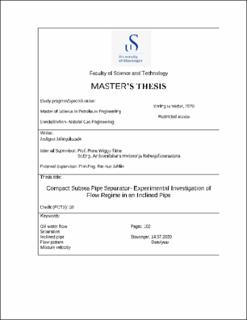| dc.description.abstract | The production of petroleum from well is always accompanied by water production, which causes several problems such as loss of pressure in the production line, environmental pollution, corrosion, and issues in transportation and storage facilities. The oil and water phases need to be separated after the production. However, separation of water and oil at seabed can provide the most efficient way of separating these two phases. An inclined pipe separator can do this job safely and efficiently. The design of the subsea separator and the flow regimes of oil-water are essential for the efficiency of the separator.
The test facility was built at the Subsea 7 mechanical base, Dusavik. It consists of a 4 m long 3-inch acrylic horizontal PVC pipe, upward inclinable the 2.5 m long 8-inch IPIP separator, flow rate metering manifold, and high capacity pumping system. The pumping system consists of two centrifugal pumps, both equipped with control systems to have desired rates. Tap water and Exxsol D60 are the working fluids. The tests are performed in three mixture flow rate: 0.3 m/s, 0.5 m/s, and 0.8 m/s. Three pressure transducers are installed in the IPIP separator. Signals from measurement sources are collected and digitized for storage, analysis, and presentation on a personal computer (PC) by the data acquisition system. Flow regimes are determined by visual observation with video recording, and a flow pattern map is made for each condition.
According to the experiments and literature study, the flow regimes of oil and water alter from stratified flow to dispersed flow pattern as pipe inclination shifts from horizontal to vertical. Besides, the oil-water flow pattern in pipe behaves as dispersed flow at high mixture velocity (more than 0.8 m/s). Based on the experiments, it is noticeable that the new design of IPIP separator separates more water at the condition of low (0.3 m/s) and medium (0.5 m/s) mixture velocity cases with 90 % water cut.
This study has shown that the stratified flow regime of the oil-water mixture in the inlet of IPIP separator has a reasonable effect on the efficiency of the separation. | en_US |
